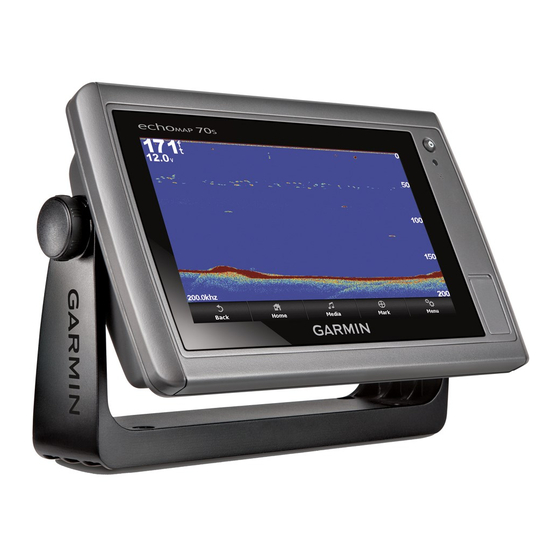• To set the depth range of the magnified area manually,
select Manual, select View Up or View Down to set the
depth range of the magnified area, and select Zoom In or
Zoom Out to increase or decrease the magnification of
the magnified area.
• To set the depth and zoom automatically, select Auto.
• To cancel the zoom, select No Zoom.
Setting the Scroll Speed
You can set the rate at which the sonar image moves across the
screen. A higher scroll speed shows more detail, especially
while moving or trolling. A lower scroll speed displays sonar
information on the screen longer. Setting the scroll speed on
one sonar view applies to all the sonar views.
1
From a sonar view, select Menu > Sonar Setup > Scroll
Speed.
2
Select an option:
• To adjust the scroll speed automatically using speed-over-
ground or water speed data, select Auto.
The Auto setting selects a scroll rate to match the boat
speed, so targets in the water are drawn with the correct
aspect ratio and appear less distorted. When viewing
DownVü or SideVü sonar views, it is recommend to use
the Auto setting.
• To use a very fast scroll speed, select Ultrascroll®.
The Ultrascroll option quickly scrolls new sonar data, but
with a reduced image quality. For most situations, the Fast
option provides a good balance between a quickly
scrolling image and targets that are less distorted.
Sonar Frequencies
NOTE: The frequencies available depend on the chartplotter,
sounder modules, and transducer being used.
Adjusting the frequency helps adapt the sonar for your particular
goals and the present depth of the water.
Higher frequencies use narrow beam widths, and are better for
high-speed operation and rough sea conditions. Bottom
definition and thermocline definition can be better when using a
higher frequency.
Lower frequencies use wider beam widths, which can let the
fisherman see more targets, but could also generate more
surface noise and reduce bottom signal continuity during rough
sea conditions. Wider beam widths generate larger arches for
fish target returns, making them ideal for locating fish. Wider
beam widths also perform better in deep water, because the
lower frequency has better deep water penetration.
CHIRP frequencies allow you to sweep each pulse through a
range of frequencies, resulting in better target separation in
deep water. CHIRP can be used to distinctly identify targets, like
individual fish in a school, and for deep water applications.
CHIRP generally performs better than single frequency
applications. Because some fish targets may show up better
using a fixed frequency, you should consider your goals and
water conditions when using CHIRP frequencies.
Some sonar black boxes and transducers also provide the ability
to customize preset frequencies for each transducer element,
which enables you to change the frequency quickly using the
presets as the water and your goals change.
Viewing two frequencies concurrently using the split-frequency
view allows you to see deeper with the lower frequency return
and, at the same time, see more detail from the higher
frequency return.
Selecting Frequencies
NOTE: You cannot adjust the frequency for all sonar views and
transducers.
Sonar
You can indicate which frequencies appear on the sonar screen.
1
From a sonar view, select Menu > Frequency.
2
Select a frequency suited to your needs and water depth.
For more information on frequencies, see
Frequencies, page
19.
Creating a Frequency Preset
NOTE: Not available with all transducers.
You can create a preset to save a specific sonar frequency,
which allows you to change frequencies quickly.
1
From a sonar view, select Menu > Frequency.
2
Select Add.
3
Enter a frequency.
Customizing the Panoptix Sonar Views
NOTE: Not all models support Panoptix transducers.
Calibrating the Compass
Before you can calibrate the compass, the transducer must be
installed far enough away from the trolling motor to avoid
magnetic interference, and deployed in the water. Calibration
must be of sufficient quality to enable the internal compass.
NOTE: Compass calibration is available only for transducers
with an internal compass.
You can begin turning your boat before calibrating, but you must
fully rotate your boat 1.5 times during calibration.
1
From the LiveVü Forward sonar page, select Menu > Sonar
Setup > Installation.
2
If necessary, select Use AHRS.
3
Select Calibrate Compass.
4
Follow the on-screen instructions.
Adjusting the Appearance of the LiveVü Sonar Views
1
From a LiveVü sonar view, select Menu > Sonar Setup.
2
Select an option:
• To change the colors of the sonar view, select Color
Scheme, and select an option.
• To adjust the length of the trails that show target
movement, select Trails, and select an option.
• To distinguish the bottom from the water by coloring the
bottom brown, select Bottom Fill.
• To show or hide the range grid lines, select Grid Overlay.
• To hide or show the history on the side of the screen,
select Scroll History.
Setting the LiveVü Transducer Transmit Angle
You can change the LiveVü transducer transmit angle to aim the
transducer at a particular area of interest. For example, you
might aim the transducer to follow a bait ball or focus on a tree
as you pass it.
1
From a LiveVü sonar view, select Menu > Transmit Angle.
2
Select an option.
Adjusting the RealVü Viewing Angle and Zoom Level
You can change the viewing angle of the RealVü sonar views.
You can also zoom in and out of the view.
From a RealVü sonar view, select an option:
• To adjust the viewing angle diagonally, select
• To adjust the viewing angle horizontally, select
• To adjust the viewing angle vertically, select
• To adjust the viewing angle, swipe the screen in any
direction.
• To zoom in, spread two fingers apart.
Sonar
.
.
.
19

